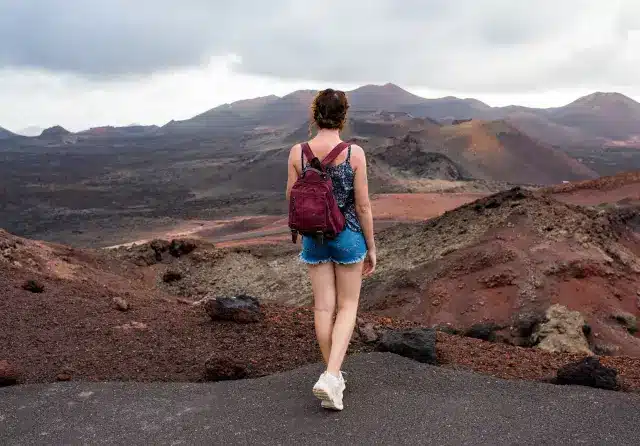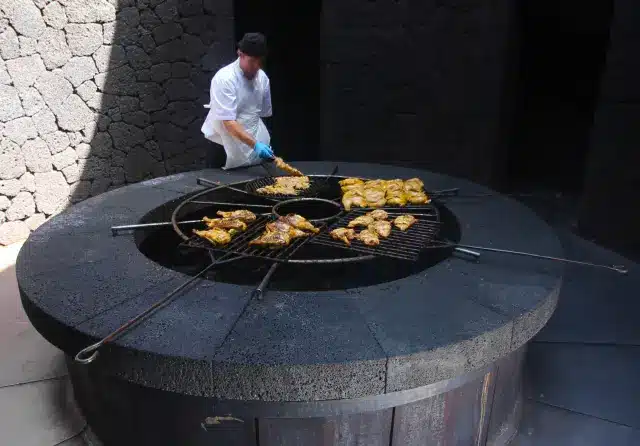
Timanfaya National Park offers a unique landscape, shaped by volcanic eruptions that occurred between 1730 and 1736, and later in 1824. The park features vast fields of solidified lava, craters, and unique geological formations that create an almost extraterrestrial environment. Visitors can witness geothermal demonstrations that highlight the intense heat still present beneath the surface, making it a fascinating destination for nature lovers and geology enthusiasts. The park’s dramatic scenery, combined with its rich history and scientific value, makes it a must-visit attraction in Lanzarote.
What to expect during your visit
A visit to Timanfaya National Park offers an immersive experience in Lanzarote’s volcanic landscape. The main highlight is the “Route of the Volcanoes,” a guided bus tour that takes visitors through the park’s most impressive areas, offering stunning views and informative commentary. Due to conservation efforts, independent exploration is limited, but visitors can enjoy camel rides along the park’s outer edges and viewpoints offering panoramic perspectives of the rugged terrain. Expect to see steam geysers, volcanic grills used for cooking, and a surreal environment that resembles another planet.
HOW TO GET TO TIMANFAYA NATIONAL PARK
Getting to Timanfaya National Park is straightforward, with several transportation options available. Renting a car is the most flexible option, allowing visitors to enjoy a scenic drive through Lanzarote’s volcanic landscapes via the well-signposted LZ-67 road, which connects Yaiza and Tinajo and provides direct access to the park.
For those who prefer not to drive, guided tours are available from popular tourist areas such as Puerto del Carmen, Playa Blanca and Costa Teguise. These tours typically include transportation, expert commentary, and visits to other nearby attractions.
Public buses do not go directly to the park but connect major towns to nearby locations such as Yaiza. From there, visitors need to take a taxi or join an organised excursion to reach the park entrance. Renting a car or booking a guided tour remains the most practical and convenient way to visit Timanfaya.
Parking and accessibility
The park provides designated parking areas for visitors arriving by car, ensuring easy access to the main attractions. However, during peak seasons, spaces can fill up quickly, so arriving early is recommended. Accessibility within the park is limited due to its rugged terrain, but facilities at the visitor centre, including restrooms and dining options, are designed to accommodate a range of needs. Visitors with mobility challenges can still enjoy some viewpoints and participate in the guided bus tours, which offer an excellent way to explore the park without extensive walking.
OPENING HOURS AND ENTRY FEES
Park Opening Times
Timanfaya National Park is open daily from 9:30 a.m. to 3:45 p.m., with the last admission at 3:45 p.m. Unlike previous years, there are no extended hours during the summer. It is recommended to check the official website for any updates on visiting hours before your trip.
Ticket prices and discounts
Entrance fees to the park are as follows:
- Adults: €12
- Children (7-12 years): €6
- Children under 7: Free entry
- Canary Islands residents: €9.60 (adults), €4.80 (children 7-12 years)
- Lanzarote residents: €2
- Visitors with disabilities: 30% discount on the standard fee.
Tickets can be purchased at the park’s ticket office or online through the official website of the Centres for Art, Culture, and Tourism (CACT) of Lanzarote. Proper documentation is required to access discounted rates.
Tips for avoiding crowds
To enjoy a more peaceful experience, it is best to visit the park early in the morning or later in the afternoon when fewer tourists are present. Weekdays tend to be less crowded than weekends, and visiting outside of peak holiday seasons can also help avoid long queues. Arriving early can further enhance the experience by minimizing wait times.
WHAT TO SEE IN TIMANFAYA
Ruta de los volcanes (The volcanoes route)
Experience the awe-inspiring landscapes of Timanfaya through a guided bus tour that takes you deep into the heart of the volcanic terrain. The route reveals vast lava fields, craters, and unique rock formations that narrate the story of the dramatic eruptions that shaped the island between 1730 and 1736. Due to conservation efforts, visitors cannot explore this area on foot, making the guided tour the only way to access the park’s most spectacular features.

Panoramic view of Timanfaya’s volcanic landscape, featuring lava fields and craters formed by historic eruptions.
Geothermal experiments
At Islote de Hilario, park staff conduct demonstrations showcasing the geothermal activity still present beneath the surface. Visitors can observe impressive experiments, such as dry brush combusting instantly when placed in a fissure, and water being poured into the ground erupting as a steam geyser. These demonstrations highlight the intense underground heat, which reaches temperatures of up to 600°C just a few meters below the surface.
Must-see viewpoints
Several designated viewpoints provide breathtaking panoramic vistas of Timanfaya’s rugged terrain. These spots are strategically located to capture the dramatic contrasts of black lava fields, red craters, and distant volcanic cones. The viewpoints offer excellent opportunities for photography and a deeper appreciation of the park’s geological wonders.
Unique flora and fauna
Despite the harsh volcanic environment, Timanfaya supports a surprising variety of plant and animal species that have adapted to the extreme conditions. Lichens, which are among the first organisms to colonize volcanic rock, can be seen clinging to the lava surfaces. Small invertebrates and birds such as kestrels and ravens have also found ways to thrive in this seemingly inhospitable landscape. Observing these resilient life forms adds another layer of fascination to your visit.
RECOMMENDED ACTIVITIES AND EXPERIENCES
Guided bus tours
The park offers guided bus tours that take visitors through the most iconic volcanic landscapes. These tours provide informative commentary on the history and geology of the area.
Camel rides
For a unique experience, visitors can take a camel ride along the outer edges of the park. This traditional activity allows for a different perspective of the volcanic terrain.
Hiking trails around the park
While access inside the park is restricted, several hiking trails around its borders offer stunning views of the volcanic landscape and an opportunity to appreciate its unique features up close.
Photography spots
Timanfaya provides a wealth of photography opportunities, with its striking contrasts of black lava, red craters, and sweeping vistas. The park’s viewpoints and trails offer excellent spots to capture its dramatic scenery.
TIPS FOR VISITING
Best time to visit
The best time to visit Timanfaya National Park is early in the morning or late in the afternoon to avoid the midday heat and crowds. Cooler months, such as spring and autumn, offer more comfortable temperatures for exploring.
What to bring and wear
Visitors should wear comfortable, sturdy footwear suitable for walking on uneven terrain. Lightweight clothing, sunscreen, and a hat are essential to protect against the sun. Bringing water and snacks is recommended, as facilities within the park are limited.
Rules and recommendations
To help preserve the park’s unique ecosystem, visitors should stay on designated paths and follow all park regulations. Littering is strictly prohibited, and touching or removing volcanic rocks is not allowed. Respecting the natural environment ensures the park remains pristine for future visitors.
Practical information
Available services in the park
Timanfaya National Park offers several visitor amenities, including restrooms, a restaurant featuring food cooked using geothermal heat, and a souvenir shop with local products and park-related merchandise.
Visitor centres and contact details
The Lanzarote Timanfaya visitor centre provides detailed information about the park’s history, geology, and conservation efforts. Staff are available to answer questions and provide assistance. For inquiries, visitors can contact the park through official channels or visit the website for the latest updates.

Visitor centre at Timanfaya National Park, where guests can learn about the park’s volcanic history and enjoy available amenities.
INTERESTING FACTS ABOUT TIMANFAYA
The park’s geological history
The landscape of Timanfaya National Park is the result of a series of powerful volcanic eruptions that occurred between 1730 and 1736, with a later eruption in 1824. Over a period of six years, molten lava and volcanic ash covered approximately a quarter of the island, burying entire villages and transforming the region into a barren yet strikingly beautiful terrain. Today, the park’s landscape remains largely untouched, showcasing vast lava fields, solidified magma rivers, and an array of volcanic cones known as “Montañas del Fuego” or “Mountains of Fire.” The absence of significant vegetation highlights the stark contrast between the deep reds, blacks, and ochres that define the park’s otherworldly scenery. Despite centuries passing since the last eruption, geothermal activity beneath the surface remains intense, with temperatures reaching up to 600°C just a few meters underground.
Stories about volcanic activity
Over the years, Timanfaya has inspired numerous legends and local stories, many of which reflect the awe and fear that early inhabitants felt toward the volcanic forces at play. According to historical accounts, villagers witnessed continuous eruptions, with lava fountains and ash clouds darkening the sky for weeks. Some locals believed the eruptions were a divine punishment, while others found ways to adapt to their new environment, using volcanic heat for cooking and farming the fertile volcanic soil, which proved highly productive for crops like grapes. Today, the park’s geothermal demonstrations serve as a reminder of these past events, with visitors marveling at how water poured into the ground instantly turns into steam. The park has also been a source of inspiration for scientists and artists alike, with famous Spanish artist César Manrique drawing from its dramatic landscape in his works and designs across Lanzarote.
Timanfaya National Park stands out as one of Lanzarote’s most iconic attractions, offering a rare opportunity to witness a landscape shaped by volcanic forces. Whether you explore the park through the guided bus tour, marvel at the geothermal demonstrations, or simply take in the breathtaking views, Timanfaya provides an unforgettable experience that highlights the raw power of nature. To make the most of your trip, be sure to plan ahead and consider booking your Lanzarote airport transfer in advance for a smooth and stress-free start to your vacation.
